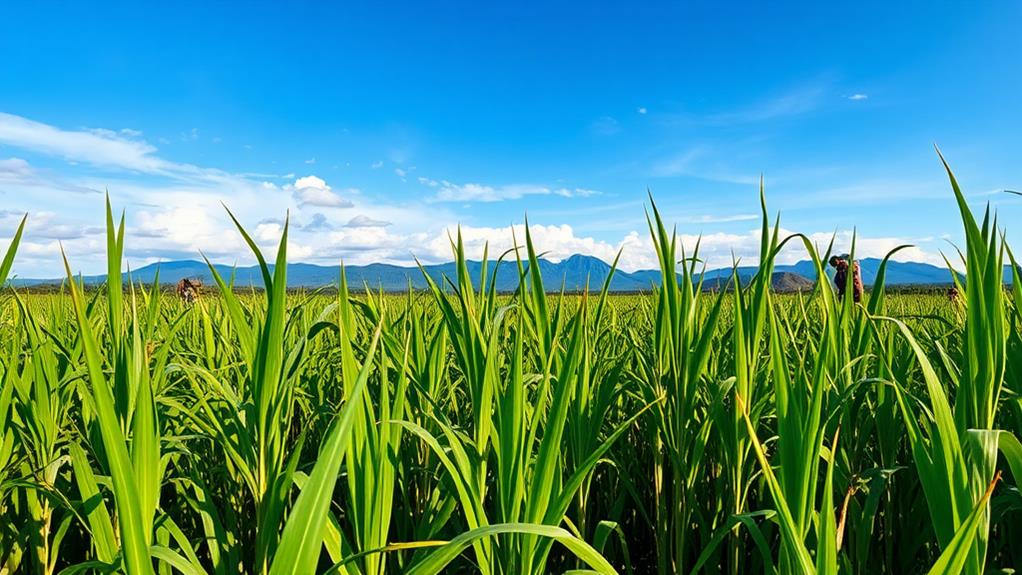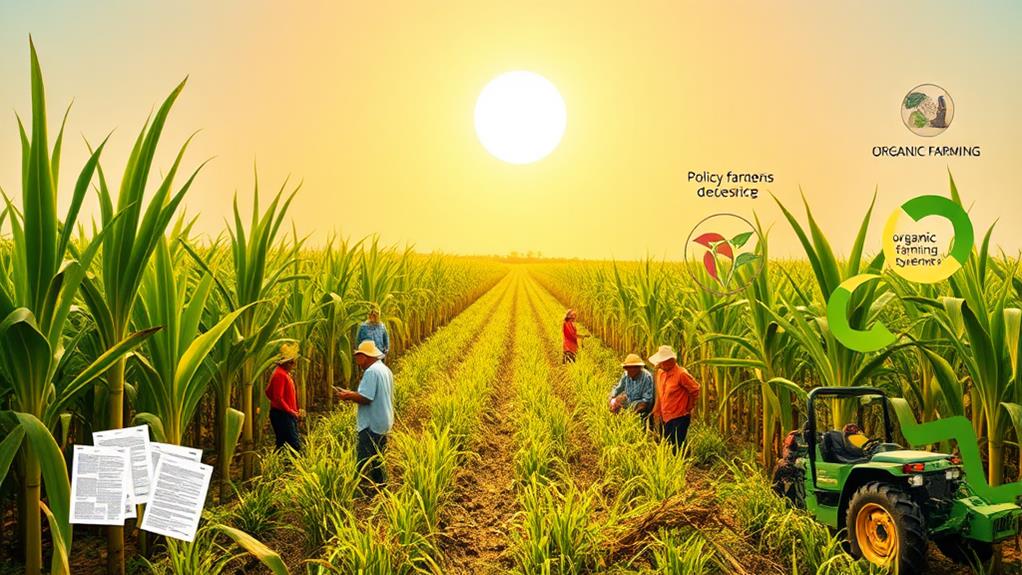The Philippine sugarcane industry makes about PhP 70 billion each year and provides jobs for over 700,000 farmers. However, it faces significant challenges. The average yield is 5.1 tons per hectare, which is much lower than countries like Colombia and Brazil.
Farmers deal with low market prices and have limited resources. They also face competition from cheaper alternatives.
Additionally, farming practices can lead to pollution and loss of biodiversity. To improve sustainability, laws like the Sugarcane Industry Development Act and programs such as Bonsucro certification are important.
Using modern technology and better farming practices can help farmers become more resilient and profitable. This could lead to a brighter and more sustainable future for the industry.
Overview of Sugarcane Production

The Philippine sugar industry is important for the economy, generating about PhP 70 billion (US$1.3 billion) each year and providing jobs for around 700,000 people.
Sugarcane is grown on approximately 422,500 hectares in the Philippines, but the average yield is only 57 tons per hectare, which is much lower than that of other countries. This indicates a need for better farming methods and new cultivation techniques.
Climate change is a significant threat to sugarcane farming. It can harm soil fertility and reduce crop productivity. Farmers need to change their practices to address these challenges.
For example, using sustainable farming methods can help improve soil health. Additionally, investing in better seeds and more efficient irrigation systems is essential to increase yields and ensure the future of the industry.
Most sugar produced in the Philippines is used locally, with 50% of it going to industrial users.
However, the country's yield of 5.1 tons per hectare is still much lower than in countries like Colombia and Brazil.
To overcome these production issues, it's crucial to focus on improving farming practices and soil quality. This focus will be vital for the sustainability of the sugar industry and the livelihoods of farmers.
Economic Challenges Facing Farmers
Sugarcane farmers in the Philippines face serious economic challenges that affect their livelihoods. Low market prices limit how much money you can make from your crops. For example, when sugar prices drop, your income decreases, making it hard to cover expenses.
Additionally, there's limited access to resources and support from government agencies, which means you mightn't get the help you need to succeed.
The average productivity for sugarcane farming is only 5.1 tons per hectare, which is much lower than farmers in other countries. This low yield makes it harder to compete with global producers.
Furthermore, you must compete with cheaper alternatives, such as artificial sweeteners, which reduces the demand for your sugar.
These issues lead to widespread debt and poverty among farmers. Many struggle to invest in better farming practices because their earnings are so low. As a result, the demand for locally produced sugar is declining.
Moreover, the slow adoption of technology makes it difficult to improve productivity and profits. Therefore, it's important for you to advocate for stronger government support and to look for new solutions to improve the sugarcane industry.
Tackling these economic challenges is essential for a sustainable future in agriculture.
Environmental Impact of Cultivation

Sugarcane farming poses serious risks to the environment. The cultivation process leads to pollution, with harmful substances like silt, fertilizers, and chemical sludge contaminating freshwater ecosystems. These pollutants threaten the health of fish and other wildlife.
Monoculture practices, where only one crop is grown, cause soil degradation and worsen water pollution, harming our natural resources.
Producing one pound of refined cane sugar requires about 213 gallons of water, which raises concerns about sustainability. This heavy use of water puts pressure on local water supplies and questions the long-term health of these resources.
Additionally, runoff from sugarcane farms can damage coral ecosystems, such as the Great Barrier Reef and Mesoamerican Reef, which are vital to marine life.
Unsustainable farming practices harm ecosystems and lead to reduced biodiversity. This loss disrupts food chains and habitats.
To promote sustainability, it's crucial to change farming policies and adopt better practices. By focusing on responsible cultivation methods, we can lessen the environmental impact of sugarcane production and protect our natural resources and wildlife for future generations.
Technological Advancements and Limitations
The Philippine sugarcane industry faces several challenges that hinder its growth. Technological advancements are important for improving this sector, but there are limitations that need to be addressed.
One major limitation is slow genetic improvement. The sugarcane genome is complex, making it hard to develop better varieties quickly. For example, traditional breeding methods can take years to produce new types of sugarcane that are more productive.
Another challenge is high labor costs and the increasing occurrence of diseases. These factors reduce production efficiency. For instance, when workers demand higher wages or when crops get sick, farmers produce less sugarcane, which affects their income.
Access to modern agricultural technologies is also limited. Many farmers don't have the latest tools and machinery that can help them work more effectively. For example, using drones for monitoring crops can lead to better yields, but not all farmers can afford this technology.
Additionally, there's insufficient research on developing drought and salinity-tolerant sugarcane varieties. This is important because climate change can lead to less water and more salty soil, which are harmful to sugarcane growth.
To improve productivity, adopting innovative technologies like CRISPR/Cas genome editing is essential. This method allows for faster creation of high-yield and disease-resistant sugarcane varieties. By using this technology, farmers can deal with issues like changing weather patterns and water shortages more easily.
Improving management practices and providing access to advanced machinery can also boost production efficiency. Investing in these technologies is crucial, especially as the industry struggles with high labor costs.
What are the Challenges Faced by the Philippine Sugarcane Industry in Terms of Sustainability and Global Demand?
The Philippine sugarcane industry faces challenges in sustainability and meeting global demand. Climate change affects production, while competition from other sugar-producing countries adds pressure. Despite these obstacles, the industry can learn from the successful strategies of the Philippine coconut industry to overcome these challenges and thrive in the global market.
Policy Framework and Support

The Philippine sugarcane industry faces challenges that require strong policies and support. The Sugarcane Industry Development Act (RA 10659) provides PhP 2 billion to improve the sugar industry, but it's still early in its implementation, causing uncertainty about the benefits for farmers.
The Sugar Regulatory Administration (SRA) manages the supply and pricing of sugar through the Quedan System, which helps protect local farmers from price swings.
Despite these efforts, issues remain. The Philippine Council for Agriculture, Aquatic, and Natural Resources Research and Development (PCAARRD) stresses that the funding must effectively reach farmers to promote sustainability.
Furthermore, the Biofuels Act (RA 9367) aims to lessen the need for imported fuel and support environmental goals, but it faces challenges with the availability of feedstock.
The Sugarcane Industry Development Act aims to boost the sugar industry by investing in block farms, socialized credit, and infrastructure.
Improving management and support systems is essential for overcoming these challenges and ensuring the long-term success of the sugar industry.
Sustainable Practices for the Future
The Philippine sugarcane industry needs to adopt sustainable practices to remain viable and competitive. By using new methods, sugar producers can improve their output and tackle issues like natural disasters and pest management.
Here are some effective strategies:
- Bonsucro certification can help producers follow responsible farming methods.
- Automated furrow irrigation systems can improve how water is used on farms.
- Soil and water conservation techniques can help reduce the need for fertilizers.
- The Sugarcane Industry Development Act (RA 10659) provides funding for sustainable projects.
In northern Negros Occidental, support programs are helping to improve sugarcane farms.
These sustainable practices not only increase production but also make farms more resilient to climate changes.
With PhP 2 billion allocated under the Sugarcane Industry Development Act, there's a great chance to enhance infrastructure and competitiveness.
By focusing on these sustainable practices, the Philippine sugarcane industry can create a healthier environment and provide long-term benefits for farmers and consumers.
Embracing sustainability today will lead to better results tomorrow.
Questions and Answers
What Are the Environmental Challenges of Sugarcane?
Sugarcane production faces several environmental challenges. Deforestation impacts occur when forests are cleared for sugarcane fields, harming wildlife habitats. Excessive water usage is a major issue, as sugarcane requires a lot of water for growth, which can lead to shortages in local areas. Soil degradation happens when the soil loses its nutrients due to over-farming, making it less productive over time.
Pesticide runoff is another concern, as chemicals used to control pests can wash into nearby rivers and lakes, harming aquatic life. Biodiversity loss occurs when sugarcane farms replace diverse ecosystems, leading to fewer plant and animal species. Rising carbon emissions are linked to sugarcane farming practices, contributing to climate change. Lastly, there is a need for enhanced climate resilience, meaning farmers must adapt practices to protect both ecosystems and their crops in changing weather conditions.
What Is the Status of Sugarcane Production in the Philippines?
Sugarcane yield trends vary because of different regional production levels and changes in the labor force. For example, some regions may produce more sugarcane due to better farming practices, while others may struggle due to a lack of workers. Government policies also play a role in influencing market demand for sugarcane. For instance, if the government offers subsidies, farmers may be encouraged to grow more sugarcane. Additionally, advancements in production technology can create new opportunities for exporting sugarcane, making the industry more competitive globally. For example, using modern equipment can increase the amount of sugarcane harvested and improve quality.
What Are the Challenges of Sugarcane?
Sugarcane farming faces several significant challenges. One major issue is labor shortages, which means there are not enough workers to harvest and manage the crops. For example, many farms struggle to find people willing to do this hard work, leading to delays in production.
Another challenge is pest management. Farmers must deal with insects and diseases that can damage sugarcane plants. For instance, pests like the sugarcane borer can destroy large areas of a crop if not controlled properly.
Climate change also affects sugarcane farming. Changes in weather patterns can lead to problems like droughts or floods, which can harm the crop yield. For example, too much rain can cause soil erosion, while too little can result in poor growth.
Additionally, market fluctuations can impact profits. The price of sugar can go up and down, making it hard for farmers to make a steady income. Lastly, technological advancements in farming methods are slow. This means farmers may not have the latest tools or techniques to improve productivity and sustainability. Overall, these challenges make sugarcane farming difficult and can threaten its future.
What Was One Negative Impact of the Sugarcane Industry?
One negative impact of the sugarcane industry is soil degradation. This happens when the land loses its nutrients and structure due to constant planting and harvesting of sugarcane. As a result, water scarcity can increase because degraded soil cannot hold water well. Additionally, this situation can lead to health risks for local communities.
Another issue is economic dependency on sugarcane, which can be unstable. When prices drop, farmers may struggle financially. This can result in labor exploitation, where workers are paid less and work in poor conditions. Furthermore, the need for more land can lead to deforestation, which harms local ecosystems and wildlife. These factors combined create significant challenges for both communities and the environment.